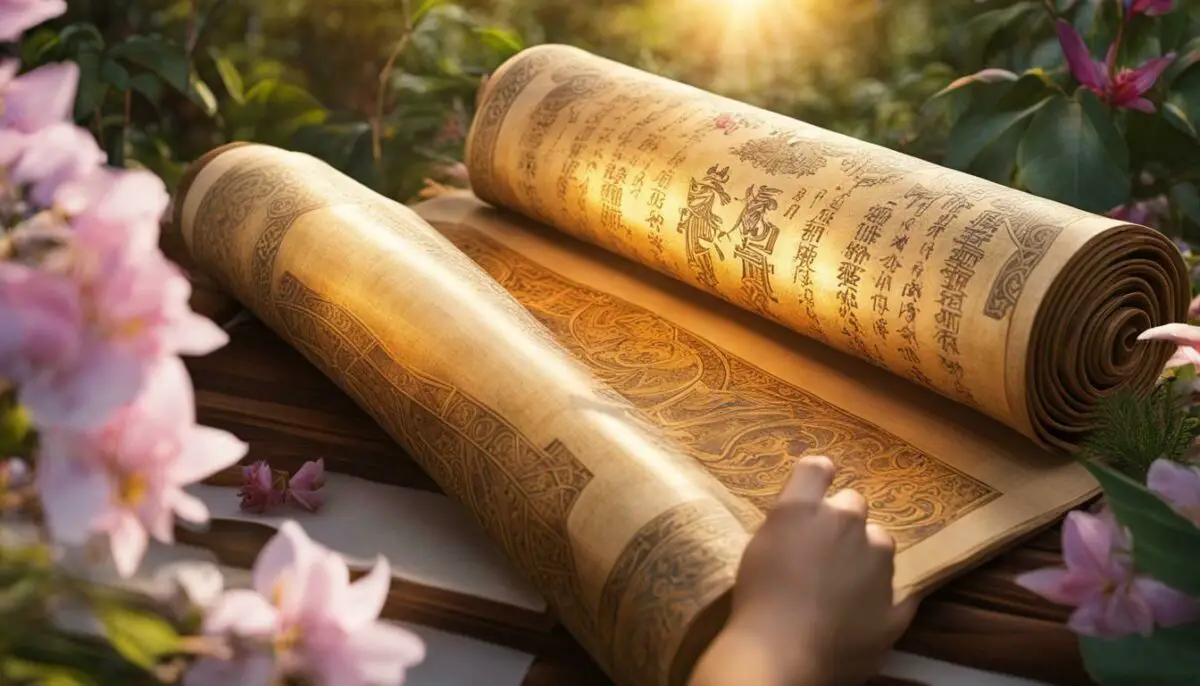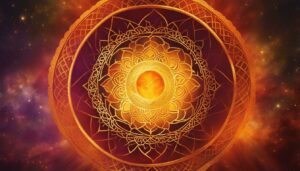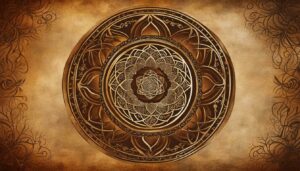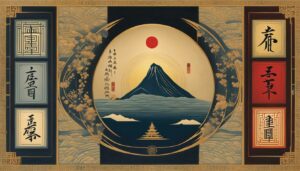Welcome to our journey through Reiki’s past, a story of healing that has captivated practitioners for centuries. In this section, we will delve into the fascinating history of Reiki, tracing its origins and exploring how it has evolved over time. From its humble beginnings with Dr Mikao Usui, a Christian headmaster and minister in Kyoto, Japan, to its rise as the most popular form of Reiki internationally, this exploration will provide a deeper understanding of this spiritual healing modality.
Key Takeaways:
- Reiki’s history can be traced back to Dr Mikao Usui, a Christian headmaster and minister in Kyoto, Japan.
- Usui’s spiritual awakening on a sacred mountain led him to receive symbols that taught him how to heal.
- Usui established a healing clinic and school in Kyoto and trained Reiki masters, including Dr Chujiro Hayashi.
- Hawayo Takata played a significant role in bringing Reiki to the West and training many Reiki masters.
- Despite the existence of other styles of Reiki, Usui Reiki became the most widely practiced form internationally.

The Origins of Reiki
The story of Reiki begins with Dr Mikao Usui, a Christian headmaster and minister who embarked on a quest for healing miracles. Driven by a deep desire to understand the secrets of ancient healing practices, Usui devoted himself to extensive study and exploration. He delved into the wisdom of the Bible, Christian scriptures, and Buddhism, seeking answers that would unlock the mysteries of spiritual and physical healing.
It was during a period of intense meditation and fasting on a sacred mountain in Japan that Usui experienced a profound spiritual awakening. In this transcendent state, he received the symbols that would become the foundation of Reiki healing. These symbols empowered Usui with the ability to channel universal life force energy for the purpose of healing oneself and others.
With this newfound knowledge, Usui established a healing clinic and school in the bustling city of Kyoto, Japan. He dedicated himself to sharing his wisdom and teachings with others, thus creating a lineage of Reiki masters who would carry on his legacy. One notable disciple was Dr Chujiro Hayashi, who played a pivotal role in further developing the Usui Reiki system and spreading its reach.
| Key Figures | Contributions |
|---|---|
| Dr Mikao Usui | Founder of Reiki, received symbols through spiritual awakening |
| Dr Chujiro Hayashi | Developed the Usui Reiki system, expanded its teachings |
With the passing of time, Reiki made its way to the West, thanks to the efforts of Hawayo Takata, a Japanese-American Reiki master. Takata played a significant role in introducing Reiki to a wider audience, training numerous Reiki masters who would carry the practice forward. Today, Usui Reiki has become the most popular and widely practiced form of Reiki worldwide, transcending the existence of other styles.
At its core, Reiki is more than just a healing modality; it is a spiritual journey that aims to improve physical and mental health. By tapping into the universal life force energy and channeling it through the hands, Reiki practitioners seek to restore balance, promote relaxation, and facilitate the body’s natural healing processes.
Dr Mikao Usui’s Spiritual Journey
Dr Mikao Usui’s spiritual journey took him on a path that combined his Christian beliefs with the wisdom of Buddhism. As a Christian headmaster and minister at Doshisha University in Kyoto, Japan, Usui sought to understand the healing miracles performed by Jesus and the Buddha. This led him to study the Bible, Christian scriptures, and Buddhist teachings, immersing himself in the ancient wisdom of these spiritual traditions.
Driven by a deep desire to uncover the secrets of healing, Usui embarked on a transformative journey. He meditated and fasted on Mount Kurama, a sacred mountain, for 21 days. It was during this time that he had a profound spiritual awakening. As the story goes, he received symbols that became the foundation of Reiki healing. These symbols taught him the art of channelling universal life force energy to heal the body, mind, and spirit.
Drawing from his Christian beliefs and Buddhist practices, Usui established a healing clinic and school in Kyoto. Here, he shared his newfound knowledge and trained several Reiki masters, including Dr Chujiro Hayashi. Hayashi played a crucial role in further developing the Usui Reiki system, refining its techniques and creating a structured curriculum for teaching.
Dr Mikao Usui’s Spiritual Journey Table
| Milestones | Details |
|---|---|
| Christian and Buddhist Studies | Usui studied the Bible, Christian scriptures, and Buddhist teachings to gain insight into healing miracles. |
| Meditation and Fasting | Usui spent 21 days meditating and fasting on Mount Kurama, where he had a profound spiritual awakening and received the healing symbols. |
| Establishment of Healing Clinic and School | Usui founded a healing clinic and school in Kyoto, Japan, to share his knowledge and train Reiki masters. |
| Training of Reiki Masters | Usui trained several Reiki masters, including Dr Chujiro Hayashi, who further developed the Usui Reiki system. |
Through the efforts of Hawayo Takata, a Japanese-American Reiki master, Reiki was introduced to the West and gained popularity worldwide. Today, Usui Reiki remains one of the most widely practiced forms of Reiki internationally, with its roots firmly grounded in Dr Mikao Usui’s spiritual journey. Reiki is not just a healing modality; it is a spiritual path that aims to improve physical and mental well-being, promoting harmony and balance within oneself and with the world.
Receiving the Healing Symbols
During a period of meditation and fasting on a sacred mountain, Dr Mikao Usui experienced a profound spiritual awakening and received sacred symbols that would become the core of Reiki healing. This pivotal moment marked the evolution of Reiki, as Dr Usui gained insights and knowledge that would shape the future of this healing modality.
The sacred symbols bestowed upon Dr Usui during his spiritual retreat were seen as powerful tools for channeling healing energy. These symbols became the foundation of Reiki healing, enabling practitioners to access and direct the universal life force energy to promote physical and emotional well-being.
By incorporating these symbols into his teachings, Dr Usui established a healing clinic and school in Kyoto, Japan, where he shared his newfound knowledge with others. He trained several Reiki masters, including Dr Chujiro Hayashi, who played a crucial role in further developing the Usui Reiki system.
| Key Players | Contributions |
|---|---|
| Dr Mikao Usui | Received the sacred symbols during a spiritual awakening on a sacred mountain |
| Dr Chujiro Hayashi | Further developed the Usui Reiki system |
These symbols, passed down from Dr Usui to his students, served as a bridge between the spiritual and physical realms, allowing individuals to tap into their innate healing abilities and facilitate the flow of energy through their hands.
Dr Usui’s spiritual experience and the symbols he received continue to be revered as the cornerstone of Reiki healing, marking a significant milestone in the historical journey and evolution of this ancient practice.
Establishing a Healing Clinic and School
Dr Mikao Usui’s passion for healing led him to establish a healing clinic and school in Kyoto, where he shared his newfound knowledge and trained future Reiki masters. Inspired by his own spiritual awakening, Usui dedicated himself to teaching others the art of Reiki, a practice that harnesses universal life energy for healing purposes.
At the clinic, Usui conducted healing sessions and taught his students the principles and techniques of Reiki. He believed that by understanding and channeling this divine energy, individuals could experience profound physical and mental healing.
Usui’s Patients and Protégés
“Reiki is a gift of love and healing that can transform lives.”
Usui’s healing clinic attracted a diverse range of patients, from those seeking relief from physical ailments to those looking for spiritual guidance. Through his teachings, Usui empowered his students to become Reiki practitioners themselves, ensuring the art of healing would continue to flourish beyond his lifetime.
One of Usui’s notable students was Dr Chujiro Hayashi, a naval officer who further developed the Usui Reiki system. Hayashi introduced new techniques and hand positions, expanding the healing potential of Reiki. His contributions were instrumental in shaping the evolution of Reiki as we know it today.
| Key Figures | Contributions |
|---|---|
| Dr Mikao Usui | Established a healing clinic and school, shared Reiki knowledge |
| Dr Chujiro Hayashi | Further developed Usui Reiki, introduced new techniques |
Through Usui’s teachings and the subsequent development of the Usui Reiki system by Hayashi, Reiki continued to gain recognition and popularity. The healing art eventually made its way to the West, thanks to the efforts of Japanese-American Reiki master, Hawayo Takata.
Takata played a pivotal role in bringing Reiki to the United States and other Western countries. She trained countless Reiki masters who went on to spread the practice further, contributing to its global reach and impact. Today, Usui Reiki remains the most widely practiced form of Reiki worldwide.
In conclusion, Dr Mikao Usui’s establishment of a healing clinic and school in Kyoto marked a turning point in Reiki’s history. Through his teachings and the subsequent contributions of his students, Reiki has evolved into a widely recognized and practiced form of spiritual healing. Its transformative power continues to inspire individuals around the world, promoting physical and mental health for those who seek its healing touch.
Dr Chujiro Hayashi and the Development of Usui Reiki
Dr Chujiro Hayashi, a dedicated student of Dr Mikao Usui, played a crucial role in further developing the Usui Reiki system and expanding its reach. Building upon the foundation laid by his mentor, Dr Hayashi made significant contributions that helped shape the evolution of Reiki.
One of Dr Hayashi’s notable achievements was the organization of Reiki into a structured format, incorporating specific hand positions and techniques for effective healing. He created a manual to guide practitioners in the practice of Reiki, outlining the various hand positions and their corresponding benefits. This structured approach allowed for a more systematic and accessible approach to the art of Reiki healing.
Dr Hayashi also introduced the concept of attunements, which involved a process of energetic initiation that enabled practitioners to channel Reiki energy more effectively. This innovative technique helped to enhance the flow and potency of Reiki energy, deepening the healing experience for both the practitioner and the recipient.
Furthermore, Dr Hayashi played a pivotal role in expanding the reach of Usui Reiki beyond Japan. He established a Reiki clinic in Tokyo and trained several Reiki masters, including Hawayo Takata, who would go on to bring Reiki to the West. This effort to share Reiki with the world helped to foster the global growth and popularity of this transformative healing modality.
| Dr Chujiro Hayashi’s Contributions |
|---|
| Organized Reiki into a structured format with specific hand positions for healing. |
| Introduced the concept of attunements to enhance the flow and potency of Reiki energy. |
| Established a Reiki clinic in Tokyo and trained several Reiki masters, including Hawayo Takata. |
Thanks to the dedication and innovation of Dr Chujiro Hayashi, the Usui Reiki system continued to flourish and gain recognition for its healing potential. Today, his contributions remain an integral part of Reiki’s rich history, demonstrating the ongoing evolution and expansion of this spiritual healing modality.
Bringing Reiki to the West: Hawayo Takata’s Role
Hawayo Takata’s journey brought Reiki from Japan to the West, where she trained many Reiki masters and helped popularize this ancient healing art. Born in Hawaii to Japanese immigrant parents, Takata faced health challenges and sought healing in Japan. It was there that she encountered Reiki and experienced its transformative power firsthand. Determined to share this gift with others, Takata trained extensively under Chujiro Hayashi, one of Dr Mikao Usui’s students, and became a Reiki master herself.
Takata’s dedication to spreading Reiki led her to establish Reiki clinics in Hawaii and the mainland United States. She also traveled extensively, teaching Reiki to students and attuning them to the healing energy. Through her efforts, Reiki gained recognition and acceptance in the Western world, paving the way for its widespread practice today.
During her teachings, Takata emphasized the importance of lineage and preserving the integrity of the Usui Reiki system. She worked closely with her students, ensuring they understood and respected the traditional teachings passed down from Dr Mikao Usui. This commitment to maintaining the authenticity of Reiki helped establish Usui Reiki as the most popular form internationally.
Takata’s legacy lives on through the thousands of Reiki masters she trained, who continue to carry forward her teachings and pass on the healing art of Reiki to future generations. Her role in bringing Reiki to the West is a testament to the universal appeal and power of this ancient practice, which continues to evolve and adapt in response to the needs of modern society.
Table: Hawayo Takata’s Lineage
| Master | Student |
|---|---|
| Dr Mikao Usui | Chujiro Hayashi |
| Chujiro Hayashi | Hawayo Takata |
| Hawayo Takata | Multiple Reiki Masters |
| Multiple Reiki Masters | Continued lineage and spread of Reiki |
References:
– International Center for Reiki Training: www.reiki.org
– “The Original Reiki Handbook of Dr Mikao Usui” by Mikao Usui and Christine M. Grimm
Usui Reiki Becomes the Most Popular Form Internationally
Usui Reiki, with its rich history and lineage, has become the most popular and recognized form of Reiki worldwide. Its origins can be traced back to Dr Mikao Usui, a Christian headmaster and minister at Doshisha University in Kyoto, Japan. Seeking answers to healing miracles, Usui embarked on a spiritual journey, studying the Bible, Christian scriptures, and Buddhism.
After meditating and fasting on a sacred mountain, Usui had a profound spiritual awakening. During this experience, he received ancient symbols that unlocked the healing power within him. These symbols became the foundation of Reiki healing, a practice that aims to improve physical and mental health.
Driven by his newfound knowledge and healing abilities, Usui established a healing clinic and school in Kyoto. His teachings attracted several Reiki masters, including Dr Chujiro Hayashi, who made further contributions to the Usui system. Through his dedication and development of the practice, Usui Reiki slowly gained recognition and began to spread beyond Japan’s borders.
One of the key figures in the globalization of Reiki was Hawayo Takata, a Japanese-American Reiki master. Takata brought Reiki to the West and played a significant role in its dissemination. Her efforts resulted in the training of numerous Reiki masters outside of Japan, effectively expanding the practice’s reach and popularity.
| Reiki History | Reiki’s Evolution |
|---|---|
| Origins in Dr Mikao Usui’s spiritual journey | Development of the Usui Reiki system by Dr Chujiro Hayashi |
| Establishment of a healing clinic and school in Kyoto | Spread to the West through the efforts of Hawayo Takata |
| Recognition as the most popular and recognized form of Reiki worldwide | Continued evolution to adapt to the needs of practitioners and the modern world |
Today, Usui Reiki continues to thrive and evolve. While different styles and forms of Reiki exist, Usui Reiki remains the most widely practiced and sought-after modality. Its rich history and lineage, combined with the transformative power it holds, have made it a staple in the world of energy healing.
The Spiritual Healing Modality of Reiki
Reiki, as a spiritual healing modality, is rooted in ancient traditions and aims to promote well-being and balance in the body, mind, and spirit. Its origins can be traced back to Dr Mikao Usui, a Christian headmaster and minister at Doshisha University in Kyoto, Japan. Driven by a deep curiosity and a desire to understand the healing miracles mentioned in ancient texts, Usui embarked on a quest for knowledge that led him to study the Bible, Christian scriptures, and Buddhism.
It was during a period of intense meditation and fasting on Mount Kurama that Usui experienced a profound spiritual awakening. In this transformative moment, he became aware of a healing energy flowing through him, and received sacred symbols that would become the foundation of Reiki healing. Inspired by this spiritual revelation, Usui established a healing clinic and school in Kyoto, where he taught others the art of Reiki.
One of his students, Dr Chujiro Hayashi, continued to develop the Usui Reiki system, further expanding its applications and refining its techniques. The teachings of Dr Hayashi eventually reached the West, thanks to the efforts of Hawayo Takata, a Japanese-American Reiki master. Takata played a significant role in spreading Reiki internationally, training many Reiki masters who would go on to share this healing modality with others.
Today, Usui Reiki is the most widely practiced form of Reiki worldwide, although other styles and variations exist. Despite its diverse expressions, the fundamental aim of Reiki remains the same – to facilitate healing and bring harmony to the physical, emotional, and spiritual aspects of an individual’s being. Through the gentle laying on of hands, Reiki practitioners channel this universal life force energy to promote relaxation, reduce stress, and support the body’s natural healing processes.
| Points to Remember |
|---|
| Reiki is a spiritual healing modality. |
| It aims to promote well-being and balance in the body, mind, and spirit. |
| Dr Mikao Usui founded the Usui Reiki system. |
| Dr Chujiro Hayashi further developed the Usui system. |
| Hawayo Takata played a significant role in bringing Reiki to the West. |
| Usui Reiki is the most widely practiced form of Reiki internationally. |
Exploring Reiki’s Past Experiences
Throughout its history, Reiki has witnessed numerous transformative experiences, offering healing and spiritual growth to countless individuals. The roots of Reiki can be traced back to Dr Mikao Usui, a Christian headmaster and minister at Doshisha University in Kyoto, Japan. Driven by a search for answers to healing miracles, Usui explored various religious teachings, studying the Bible, Christian scriptures, and Buddhism.
It was during his meditation and fasting on a sacred mountain that Usui experienced a profound spiritual awakening. In this transcendent moment, he received sacred symbols that became the foundation of Reiki healing. Inspired by this divine revelation, Usui established a healing clinic and school in Kyoto, where he taught several Reiki masters, including Dr Chujiro Hayashi.
Dr Hayashi played a vital role in further developing the Usui Reiki system. His contributions enabled Reiki to evolve and adapt, making it more accessible to a wider audience. However, it was Hawayo Takata, a Japanese-American Reiki master, who truly brought Reiki to the West. Takata’s tireless efforts in training and attuning Reiki masters played a significant role in the spread of Reiki across the globe.
Despite the presence of other styles of Reiki, Usui Reiki became the most popular and widely practiced form internationally. Its effectiveness in promoting physical and mental health, as well as its spiritual healing capabilities, have made it a sought-after modality by both practitioners and recipients.
| Key Points: | Reiki’s Past Experiences |
|---|---|
| Founder: | Dr Mikao Usui |
| Significant Figures: | Dr Chujiro Hayashi, Hawayo Takata |
| Main Principles: | Spiritual healing, improving physical and mental health |
| Evolution: | Adaptation and expansion to meet the needs of practitioners |
The Evolution of Reiki Today
Reiki, in its continued evolution, has embraced new perspectives and practices, making it accessible to people from all walks of life. As the awareness of energy healing grows, so does the interest in Reiki. Today, Reiki is not only practiced in traditional healing clinics and schools, but it has also found its place in hospitals, spas, and even corporate wellness programs.
The modern-day practice of Reiki has expanded beyond hands-on healing. Many practitioners have integrated other modalities and techniques into their Reiki sessions. This includes combining Reiki with aromatherapy, crystal healing, sound therapy, and mindfulness practices. By combining these different approaches, Reiki continues to evolve and adapt to meet the diverse needs of individuals seeking healing and relaxation.
The versatility of Reiki has led to its integration into various healthcare settings. Hospitals are incorporating Reiki into their holistic care programs, recognizing the benefits it can provide alongside other medical treatments. Research studies have shown promising results in reducing stress, anxiety, and pain for patients receiving Reiki therapy. This integration into mainstream healthcare is a testament to the growing acceptance and recognition of Reiki as a valuable healing modality.
In addition to its integration into healthcare, Reiki has also gained popularity within the personal development and wellness communities. Many individuals are seeking Reiki as a tool for self-care and personal growth. Reiki training programs are now widely available, offering certification for those who wish to become Reiki practitioners themselves. This accessibility has empowered individuals to tap into their own healing abilities and share the gift of Reiki with others.
| Benefits of Reiki Today | Integration into Healthcare | Personal Development and Wellness |
|---|---|---|
| Reduced stress, anxiety, and pain | Recognition in holistic care programs | Tool for self-care and personal growth |
| Enhanced relaxation and overall well-being | Incorporation in hospitals and spas | Empowerment through Reiki training |
| Support for mental and emotional balance | Research-backed benefits for patients | Integration with other healing modalities |
As Reiki continues to evolve, it remains rooted in its core principles of connecting to universal life force energy and facilitating healing. With its growing popularity, Reiki has become a beacon of hope and comfort for those seeking holistic and natural approaches to wellness. Whether it is for physical healing, emotional support, or spiritual growth, Reiki offers a gentle yet powerful way to restore balance and harmony in our lives.
Conclusion
The story of Reiki’s past is a testament to the power of healing and the timeless wisdom that continues to guide practitioners today. Dr Mikao Usui, a Christian headmaster and minister at Doshisha University in Kyoto, Japan, embarked on a journey to uncover the secrets of healing miracles. His exploration led him to study the Bible, Christian scriptures, and Buddhism, seeking answers to the mysteries of spiritual healing.
Through meditation and fasting on a sacred mountain, Dr Usui had a profound spiritual awakening. He received symbols that became the foundation of Reiki healing, empowering him to channel universal life force energy for the purpose of healing. Dr Usui established a healing clinic and school in Kyoto, where he taught numerous students, including Dr Chujiro Hayashi, who played a significant role in further developing the Usui Reiki system.
Hawayo Takata, a Japanese-American Reiki master, carried the torch of Reiki to the West, sharing its transformative power with a broader audience. Her efforts led to the training of many Reiki masters, ensuring that the practice would continue to spread and evolve. Despite the existence of other styles of Reiki, Usui Reiki emerged as the most popular form internationally, demonstrating its universal appeal and effectiveness.
Today, Reiki remains a spiritual healing modality that aims to improve physical and mental health. It is a practice that not only nurtures and balances the individual but also cultivates a deep connection to the universal life force energy. As Reiki continues to evolve in the modern world, it adapts to the needs of practitioners and expands its reach, touching the lives of countless individuals and communities.
Source Links
- https://www.georgianamoncktonreiki.com/the-history-of-reiki.php
- https://iarp.org/history-of-reiki/
- https://www.reiki.org/faqs/what-history-reiki




